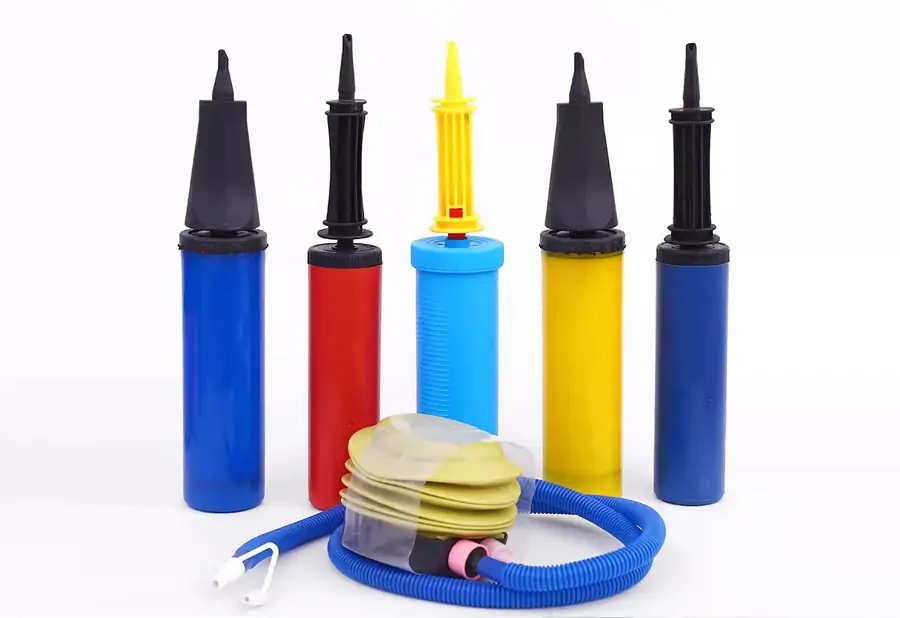I. Balloon Pump Construction
A balloon pump is composed of the cylinder, nozzle, piston, and handle. The cylinder forms the main body of the pump, typically made from plastic. The nozzle, usually made from rubber or silicone, connects the balloon to the pump. The piston, the heart of the pump, sits within the cylinder. As the handle is pulled, the piston moves downwards, compressing air that enters from the bottom, storing energy. When the handle is released, it drives the piston upwards and pushes the compressed air into the balloon, filling it with air.
II. Types and Description of Balloon Pumps
Balloon pumps can be categorized as hand-pump, electric pump, and foot-pump.

Foot pumps change the force point from hand pressure to foot pressure. Some designs come with a pressure gauge, similar to vertical pumps. They may have a single or double cylinder design, but both work on the same principle; their inflation efficiency differs. Some feature a dual-hole design for quick inflation, made from latex material.
Double-action hand pumps save more time and effort than single-action ones. They inflate both when pushing and pulling, enabling fast inflation. They also feature larger air holes for faster air intake and a three-ring design to increase the air output. They are typically made from plastic.
Single-action hand pumps are economical in design, with only a single air inlet. They inflate balloons effortlessly, making them a good choice, and are also made from plastic.
Mini plastic hand pumps are easy to carry around and possess decent power, capable of inflating numerous balloons. They are mainly used for magic balloons and long balloons, making them a little helper for inflating balloons.
III. Everyday Application of Balloon Pumps
These inflation tools are incredibly useful and can inflate balloons of various sizes for different occasions like birthday parties, weddings, advertisements, and even inflatables like swim rings.
IV. How to Use a Balloon Pump
- Insert the nozzle into the balloon.
- Secure the pump so it doesn’t wobble or fall.
- Hold the handle and pull it down to move the piston downwards.
- Release the handle to let the compressed spring push the piston upwards.
- Repeat these steps until the balloon is filled with the required amount of air.

V. Precautions When Using a Balloon Pump
- Ensure that the balloon and pump are secure during use to prevent the pump or balloon from slipping or falling.
- Check the pump for leaks or damages before inflating. If damaged, replace it promptly.
- Take breaks during inflation to avoid damaging the compression spring due to prolonged use.
- Be mindful of the balloon’s size during inflation. Don’t exceed the pump’s capacity to avoid damaging it.
VI. Troubleshooting Inflation Issues
Sometimes, you may encounter issues where the pump fails to inflate the balloon. These could be due to:
- Poor quality or damaged pump. If the pump’s interior isn’t smooth or has defects, or if it’s worn out from repeated use, the airflow will be blocked, preventing the air from entering the balloon.
- Mismatched pump and balloon sizes. Sometimes, incompatible sizes of the pump and balloon can hinder the air from being pumped into the balloon.
- Incorrect usage of inflation tools. Using different types of pumps or methods can also prevent air from entering the balloon.
If you encounter inflation problems, try the following:
- Check if the pump is damaged. If the pump is damaged or worn out, consider replacing it with a higher-quality pump or changing the inflation method.
- Ensure the pump and balloon sizes match. A mismatch can result in insufficient airflow, preventing the air from entering the balloon.
- Verify if the method of use is correct. Using incorrect tools or methods can also prevent air from getting into the balloon.
If these methods don’t work, consider other ways to inflate, such as using an air compressor, blowing tube, or mouth blowing. Key is to ensure safety and avoid the balloon from bursting.
































